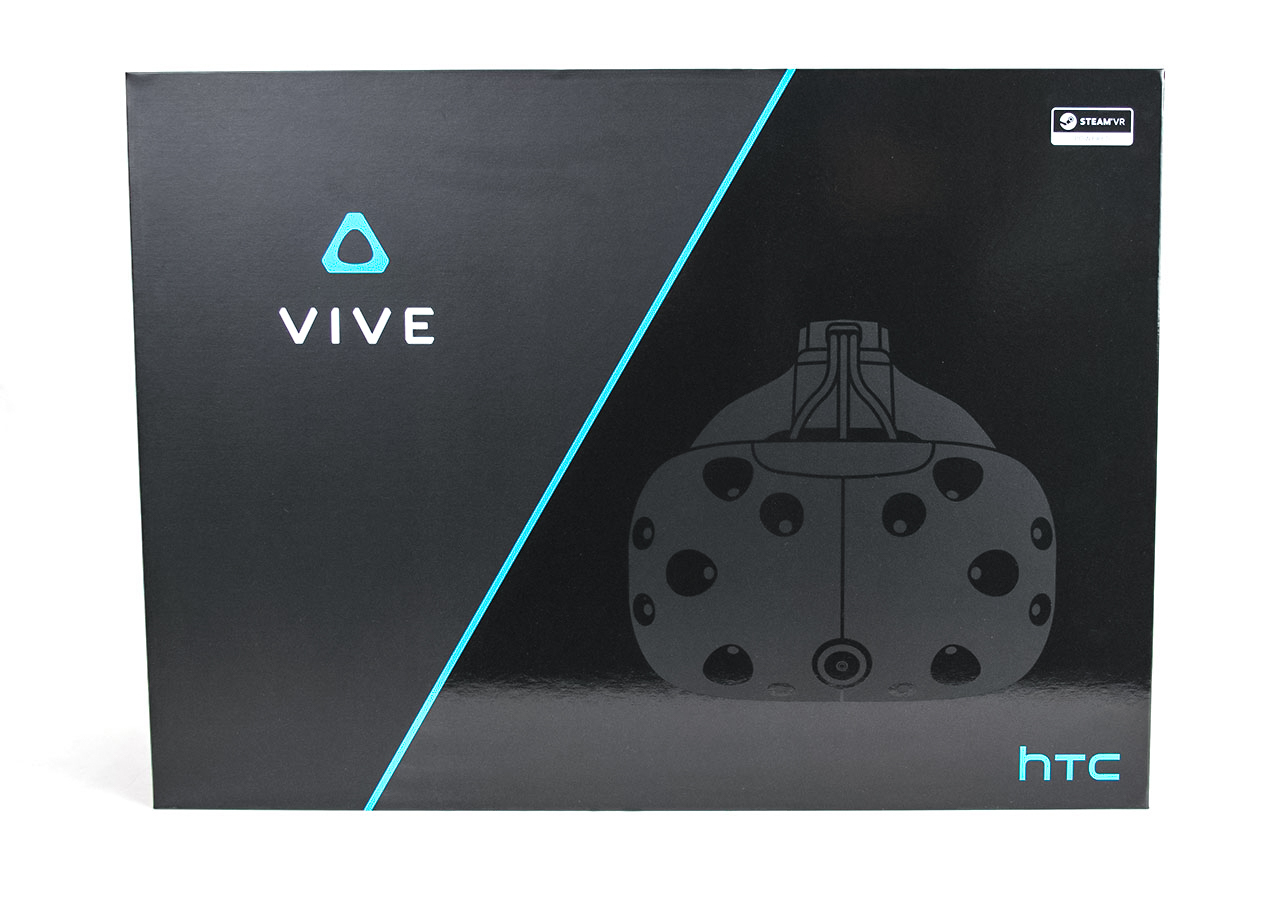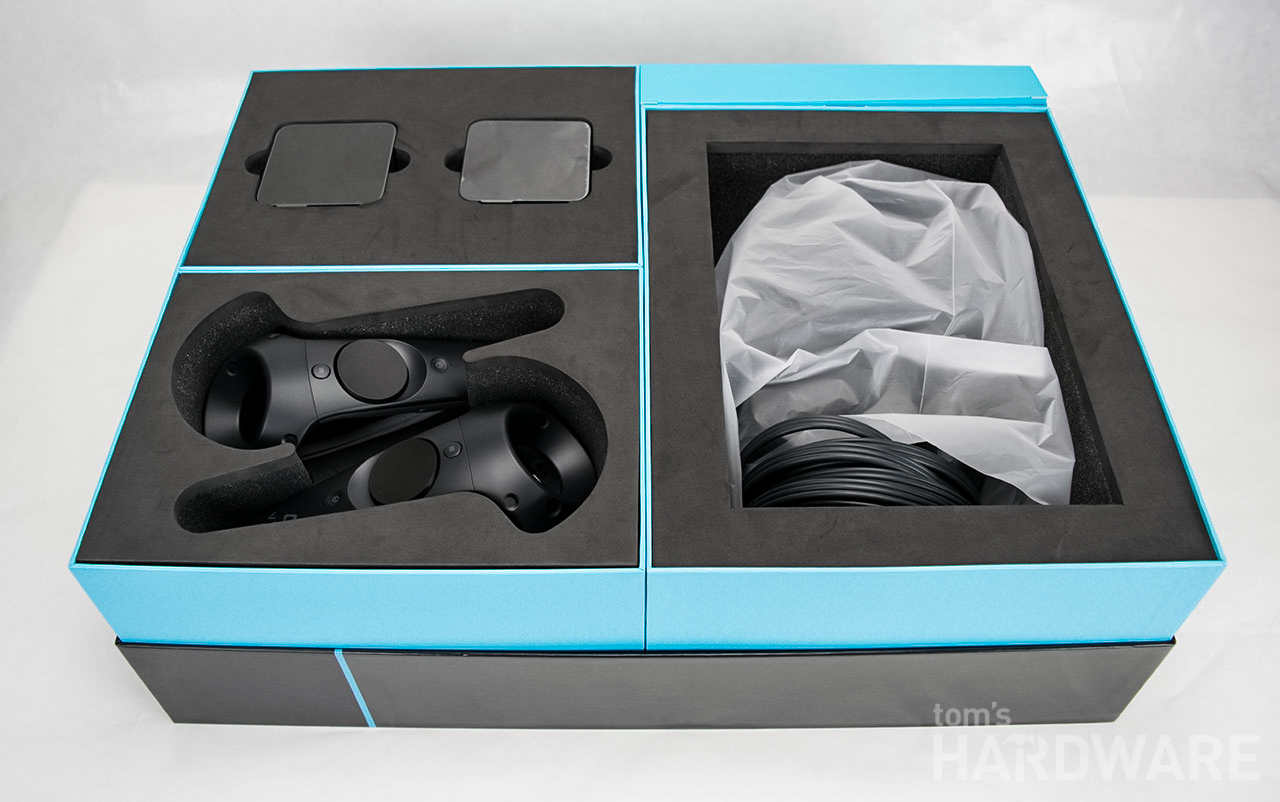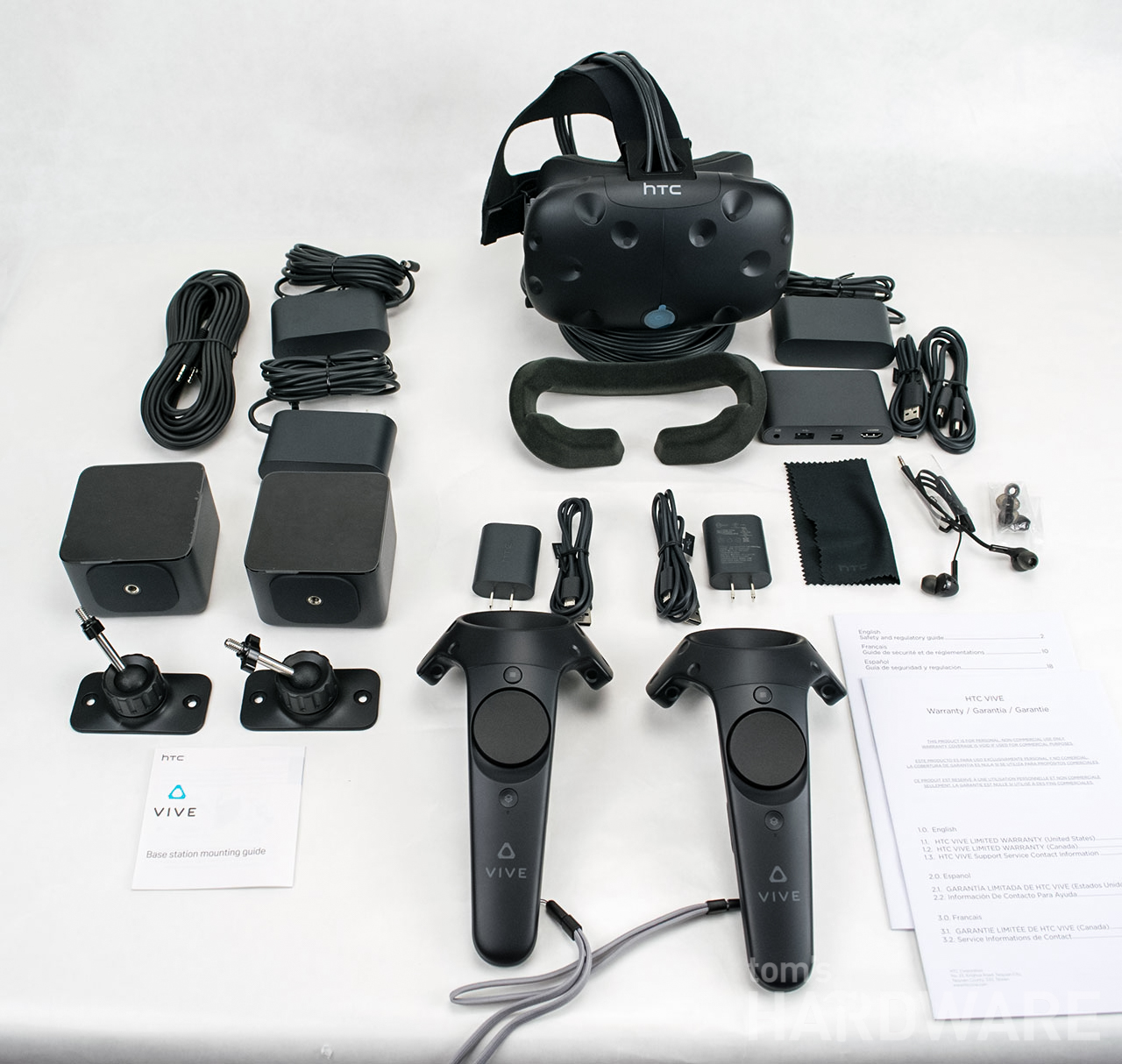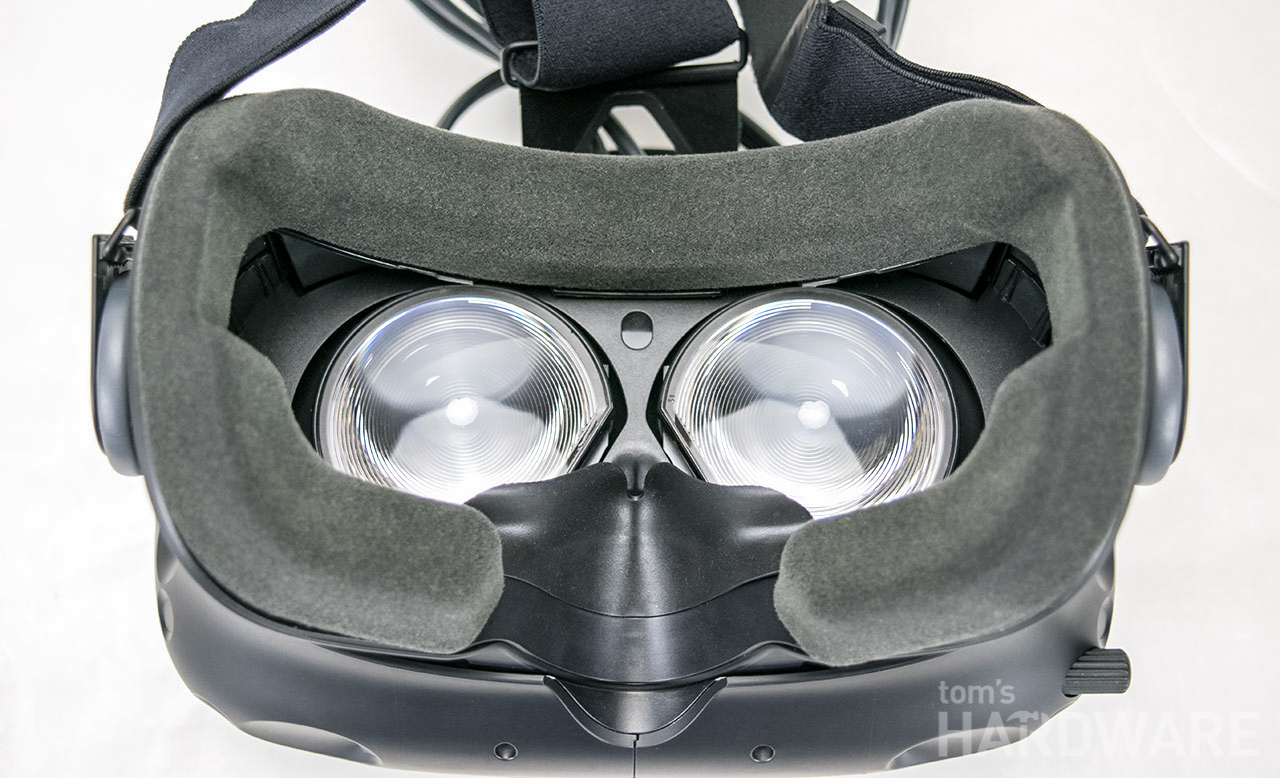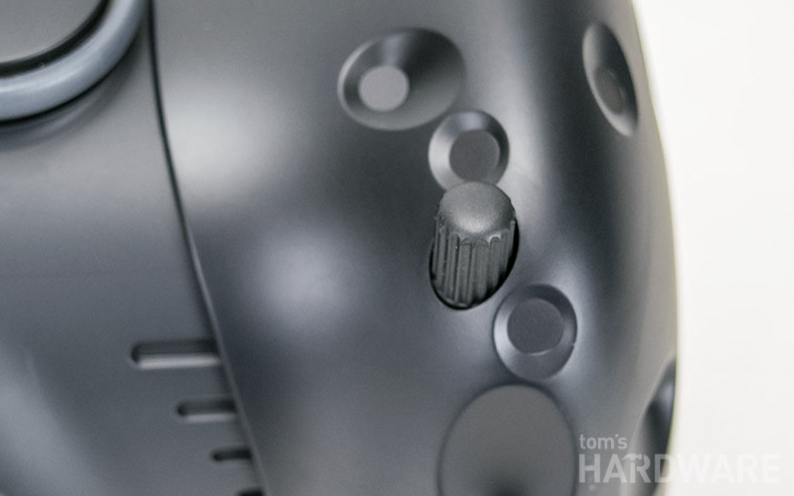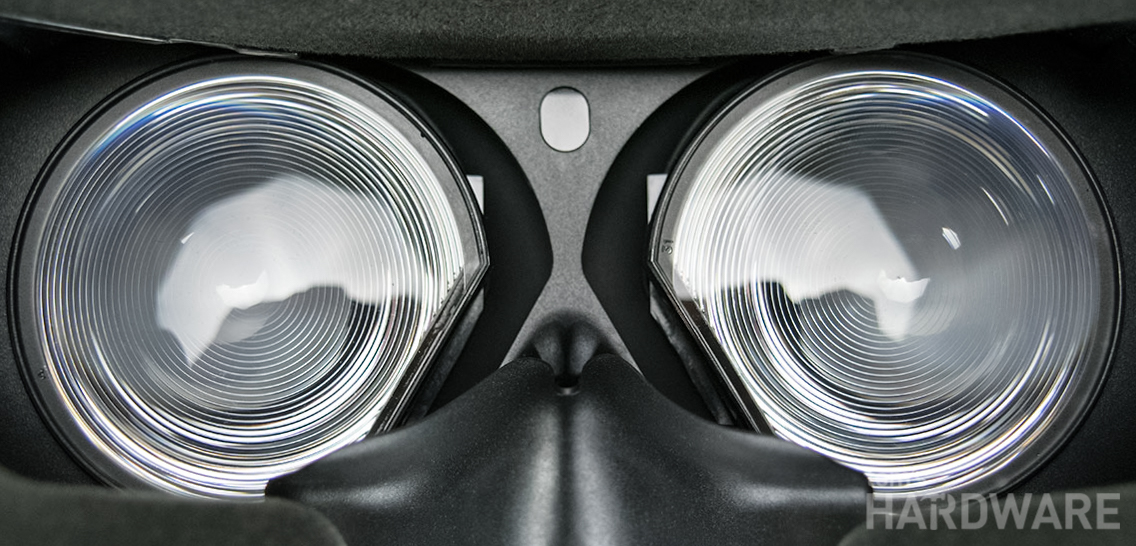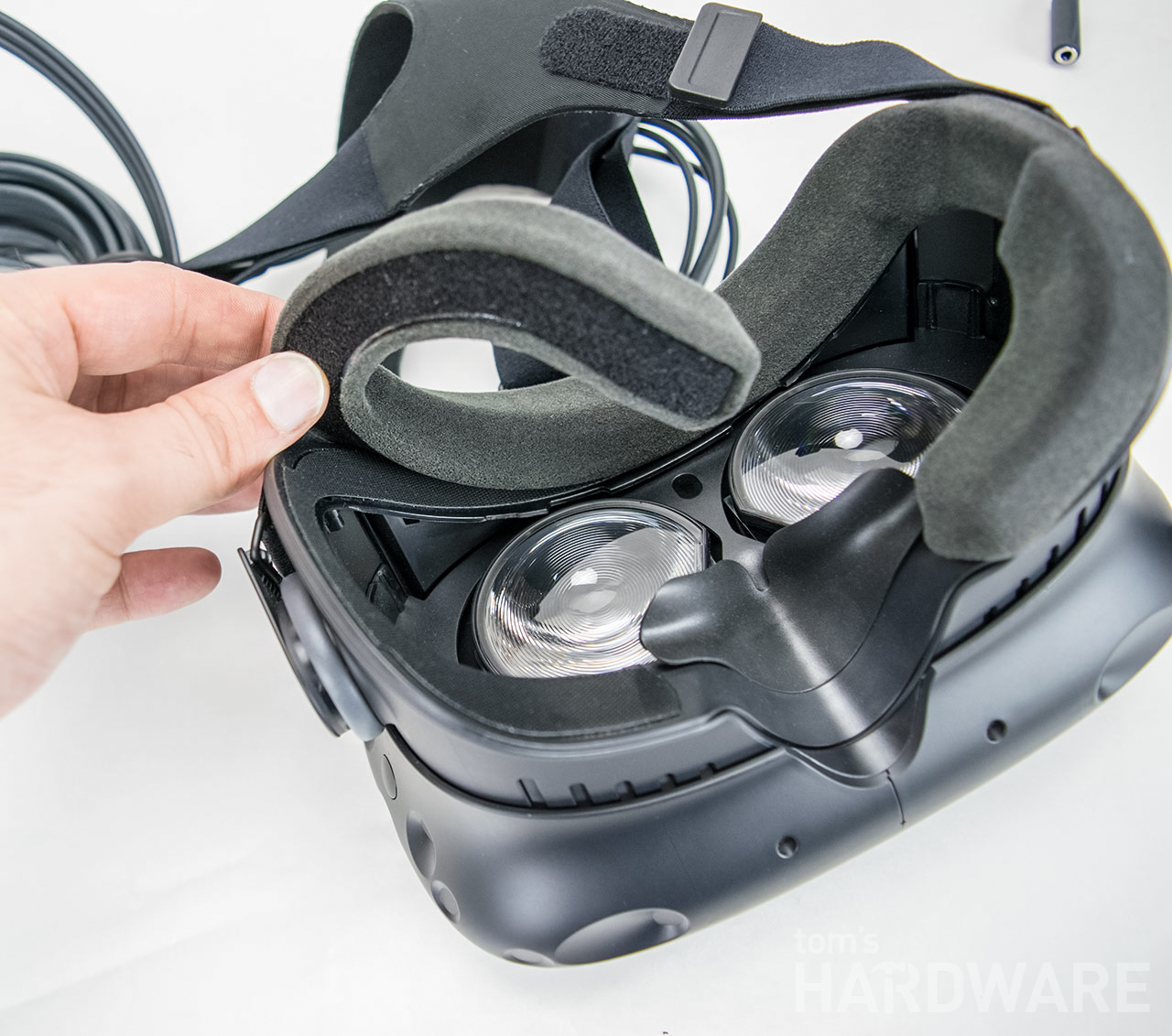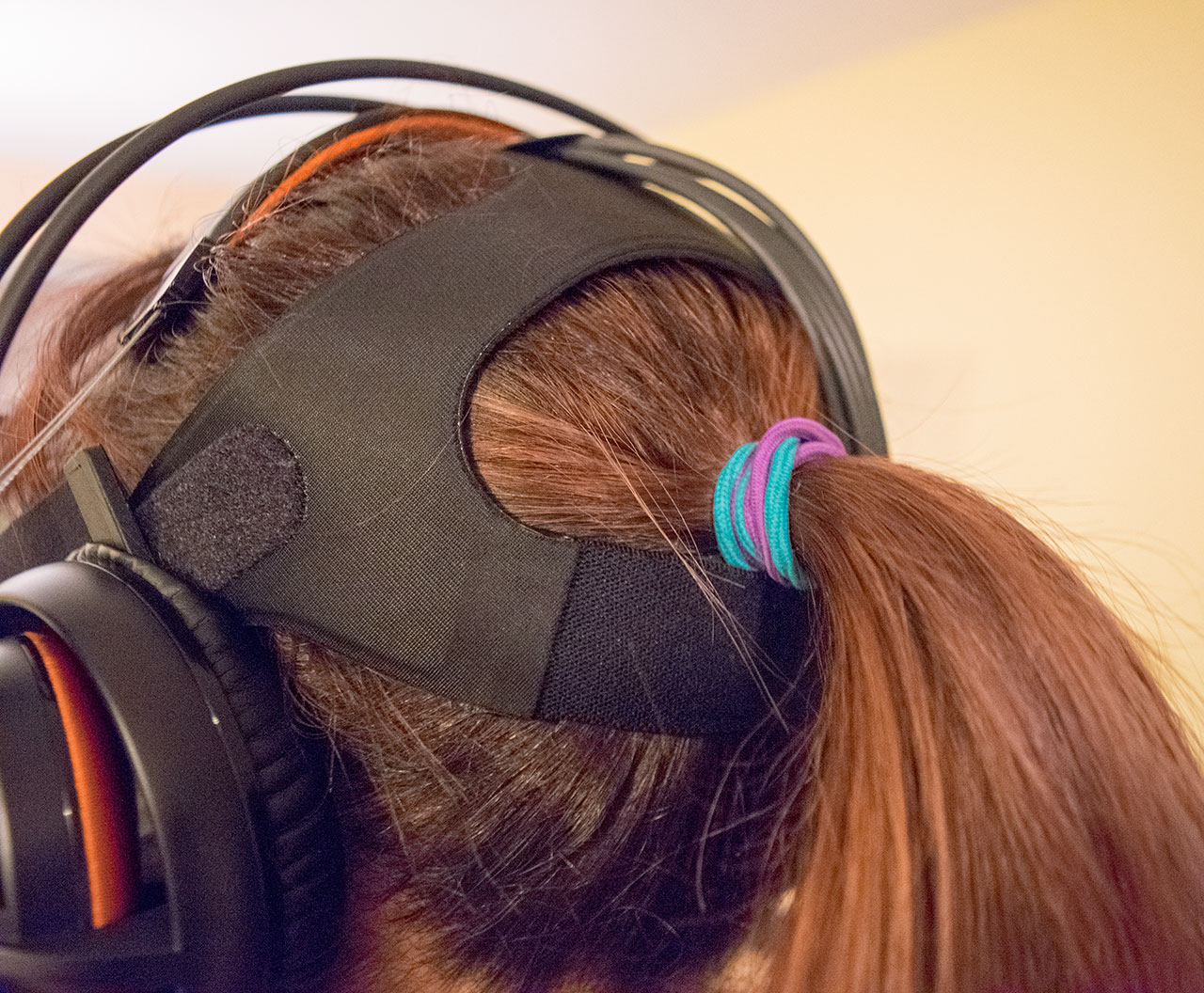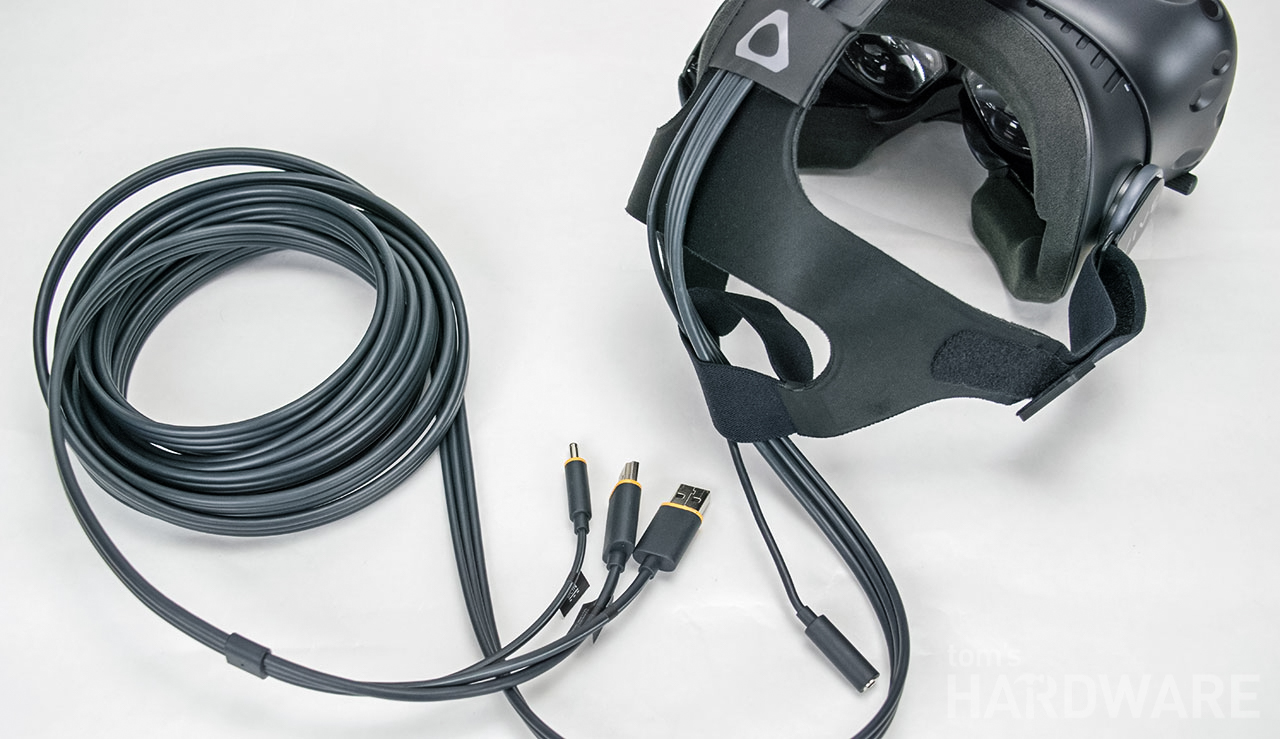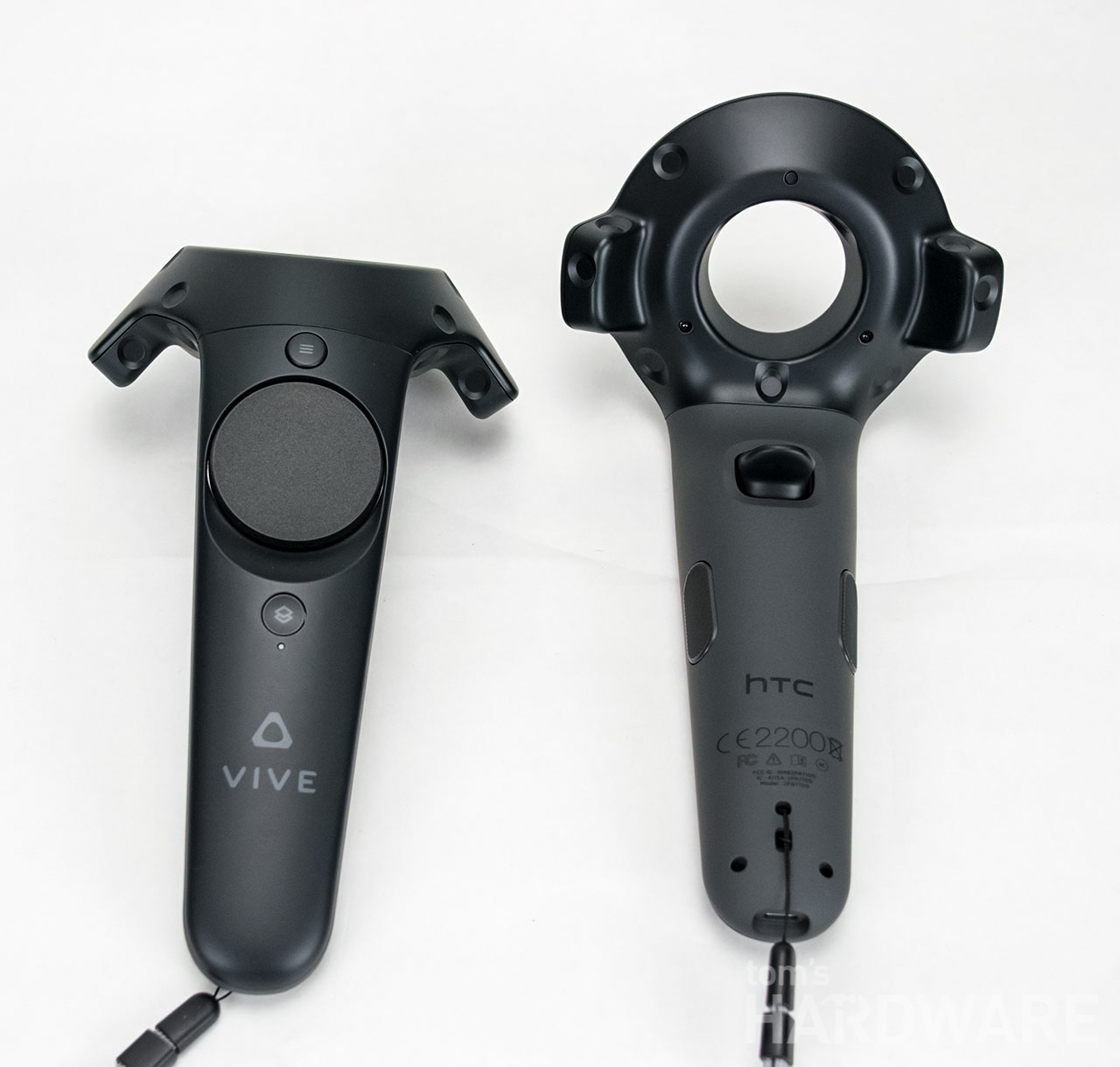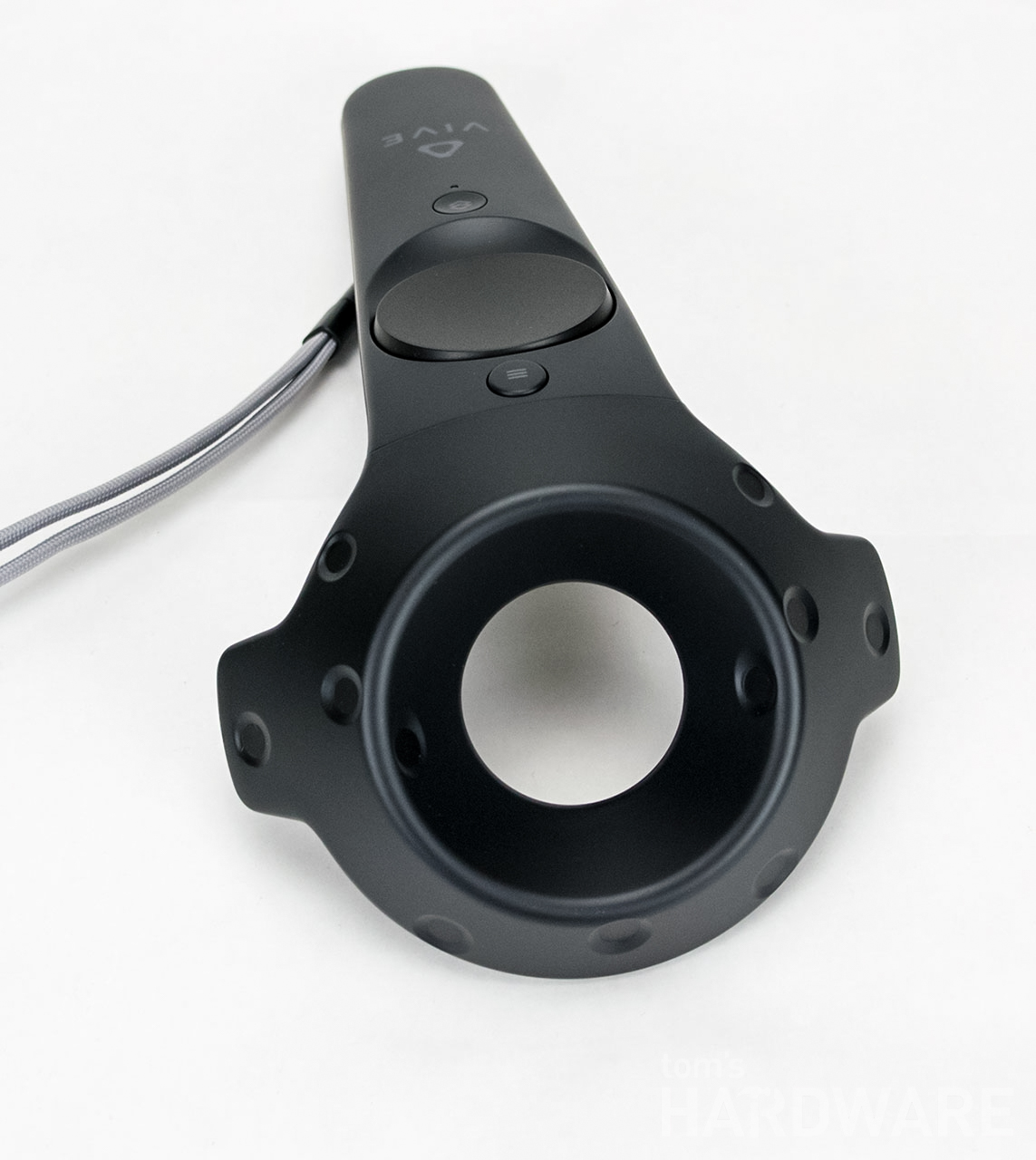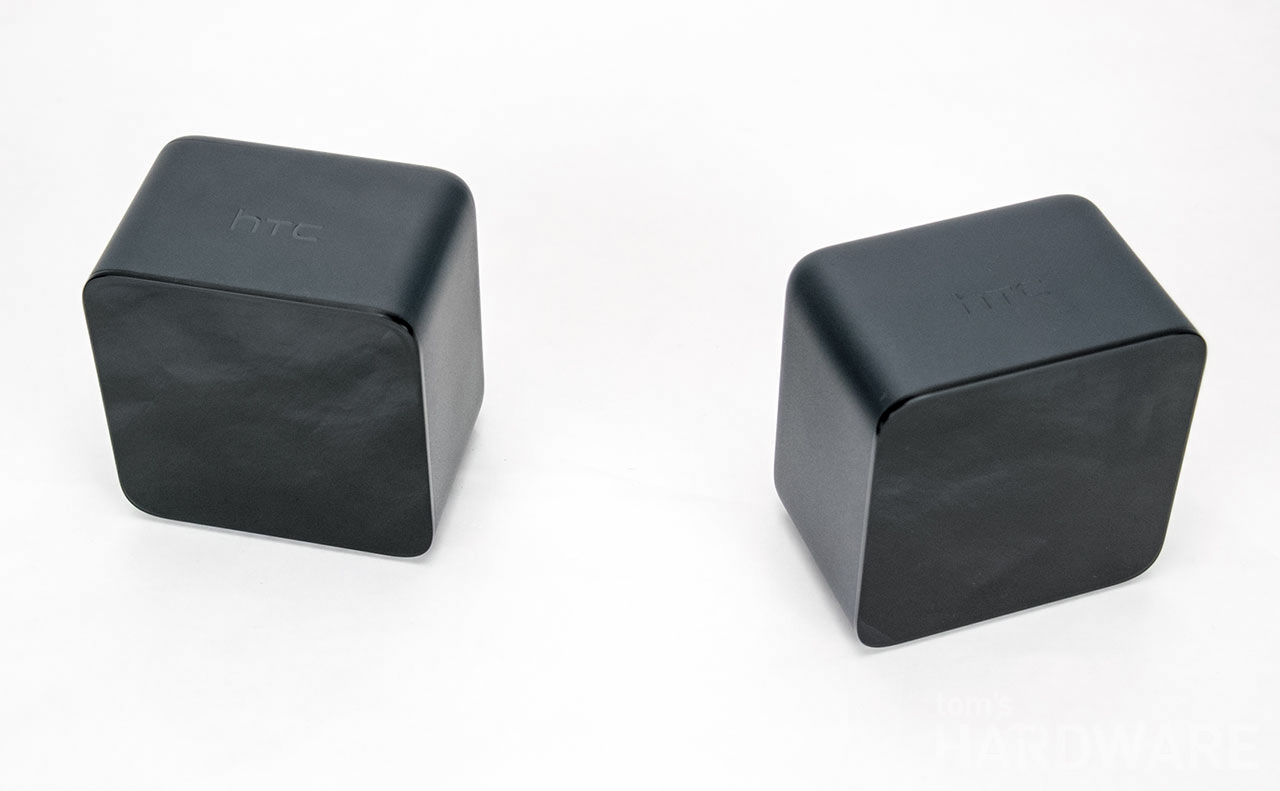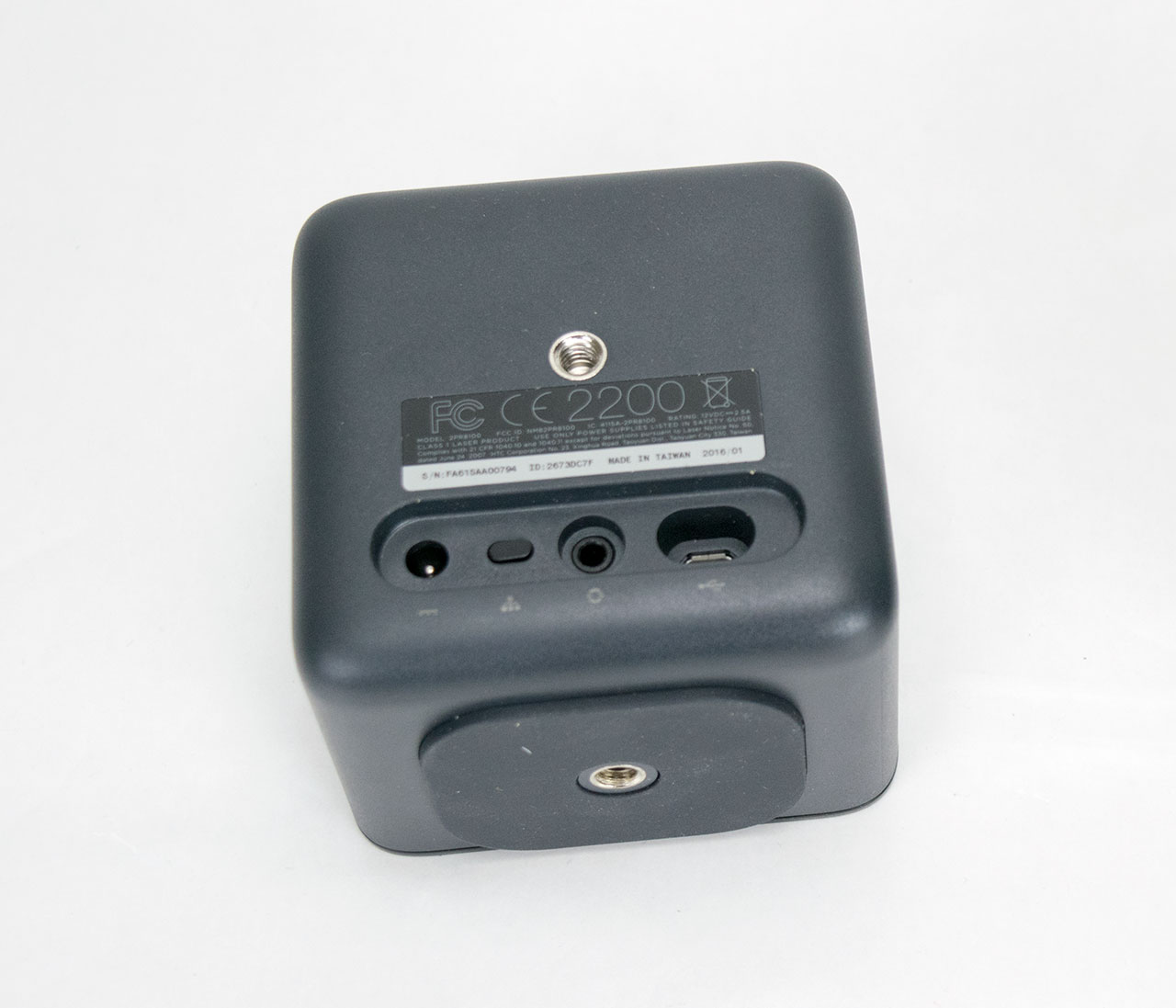The HTC Vive Review
The HTC Vive has all of the ingredients to successfully challenge the Oculus Rift, including its 6DoF hand controllers, the ability to walk around in virtual spaces and 100+ games on the way.
Why you can trust Tom's Hardware
What's In The HTC Vive Box
The box that the Vive comes packaged in is, in a word, large. It's substantially bigger than the Vive Pre's container. This turned out to be a life-saver. When the kit showed up on my doorstep, its cardboard was in dicey condition. But the inner box had several inches of buffer space protecting the actual hardware from harm.
HTC is all about presentation here, dressing the box up with a bow around it. When you lift the top off, you find a large "Get Started" guide that talks about some of the preparation you'll need to do before configuring the Vive. Under the guide, the HMD is packed in a surprising amount of soft foam. Rest assured that it'd take a deliberate act of sabotage to damage HTC's headset during shipping.
The two controllers and the Lighthouse base stations fit snugly in form-fitting foam, and the headset is in its own foam-lined compartment. Underneath the controllers, there's a compartment with the charge/sync cables and two AC-to-USB chargers. These come in handy if you don't have two available USB ports. Unlike many other products that charge through USB, HTC doesn't assume you have extra phone chargers lying around. The box for the base stations includes power cables for each unit and a 50-foot-long sync cable. HTC also includes a pair of speaker mounts for the base stations and hardware to affix them to the wall.
The HMD and its pre-attached cables sit somewhat loose in the large compartment. You'll need the Link Box to plug the system in to a computer, and that's found inside a small blue container in the upper-right corner of the Vive package, along with its power cord, a USB 3.0 cable and a four-foot HDMI cable. You'll also find instructions for the system in there, bundled earbuds and a second face gasket that helps folks with smaller heads accommodate the Vive.
You'll also get some content with your Vive. Every unit comes with codes for Owelchemy Labs' Job Simulator, Fantastic Contraption from Northway Games and Google's Tilt Brush. Valve also has a set of free mini games called The Lab that provide more than a dozen examples of what you can do with VR.
The Vive HMD
The Vive is a head-mounted VR display that provides a fully immersive gaming and entertainment experience. You slip it on like a pair of ski goggles, and are transported to a new world of virtual reality. And compared to Oculus' Rift, this system lets you get up out of your seat and explore.
HTC's take on an HMD isn't as elegant as the Rift. Whereas Oculus spent the time, effort and money to engineer a specialty fabric to cover the exterior of the headset, HTC and Valve make the shell out of hard molded plastic. The Vive's shape is also peculiar. I've heard it described as golf ball-like, and in some ways that's fairly accurate. The front is mostly rounded--bulbous, even—and it is pockmarked with indentations. These round "blemishes" house the array of IR sensors used for tracking the headset.
Get Tom's Hardware's best news and in-depth reviews, straight to your inbox.
Inside the Vive, you'll find two large Fresnel lenses. Their shape is somewhat odd: rather than being round, there is one flat side on each lens that lines up with the general angle of your nose. This is likely so that the lenses can be placed closer together for people with narrow interpupillary distances (IPD) without sacrificing lens size. Also, the lenses that HTC is using have prominent concentric rings throughout. These correspond to the different stages of focus characteristic of Fresnel lenses. The Rift's optics employ these as well, but they're much less noticeable. This might sound disconcerting, perhaps more so because the rings are visible when you look at the lenses from afar. But they aren't really bothersome with the lenses close to your eyes.
The Vive implements a number of adjustments to make your experience as comfortable as possible. First, there's an IPD dial on the right side of the headset, near the front. When you spin it, the lenses and screens move together to line up with your IPD. The headset allows customization between 60.8mm and 74.6mm. Conveniently, you can twist the dial at any given time, and you'll see an on-screen dialog that lists the current distance in millimeters, right down to the first decimal place. You can adjust the Rift's IPD on the fly too, but you must enter a specific app to see the actual measurement.


In addition to IPD dial, the Vive features a length adjustment that HTC calls the “relief” adjustment. It allows you to change lens depth, more easily accommodating gamers with glasses. Manipulating this relief setting requires turning two dials together (they're found on the head strap swivels; there’s a small gray dial hidden in the design). Simply pull the rings away from the headset to unlock the adjustment, and turn them to alter the screen depth. Once you find the sweet spot, lock them up again to keep them from shifting out of place. Just note that HTC recommends keeping changes to the relief adjustment as small as possible, since moving the lenses back affects your field of view. At best, the Vive has a 110-degree FOV, but that narrows the deeper you set the lens depth.
Without the fabric that Oculus adds to the inside of the Rift, covering the IPD adjustment mechanism, there will always be a gap between the Vive's lenses and casing. This could let dust through over time, and it doesn't appear to be easily cleaned.
Fortunately, HTC does take into account that its customers have heads with different shapes and sizes. The company includes a second face gasket with thicker foam to accommodate smaller heads. To replace the installed gasket, simply peel it off the Vive. It is held in place with a Velcro strip that is easy to swap out in a matter of seconds.
The Vive employs very similar panels as Oculus' Rift. Each eye gets its own 90Hz AMOLED display with a resolution of 1080x1200. Valve and HTC essentially take the same position as Oculus when it comes to a minimum specification for comfortable use. John Carmack, CTO of Oculus, told Gamasutra in 2014 that 90Hz is the sweet spot where roughly 95% of people don’t notice screen flicker in an HMD.
A little bird told us that the Vive's panels are actually the same as what Oculus' Rift uses, but we don't know for sure because detailed parts break-downs aren't yet available (and no, we're not ready to take either headset apart yet).
| HTC Vive Box Contents | |
|---|---|
| Hardware | Vive HMD with integrated camera and mic |
| Base Stations for tracking (2) | |
| Base Station mounting kits (2) | |
| Link Box (cable breakout box with optional Mini DisplayPort out, Bluetooth wireless connection to base stations & cell phone) | |
| In-ear stereo headphones with 30cm cord | |
| Power | 3m Base Station power adapters (2) |
| 1.2m Link Box power adapter | |
| Cables | 5m HMD 3-in-1 cable (HDMI 1.4/USB 2.0/audio, attached) |
| 1m HDMI 1.4 cable (Link Box to PC) | |
| 1m USB 2.0 cable (Link Box to PC) | |
| ~15m Optional Base Station sync cable | |
| Controls | Vive wireless controllers with lanyard (2) |
| For charging: | |
| Controller power adapters (2) | |
| Controller micro USB cables (2) | |
| Miscellaneous | Cleaning cloth |
| Additional interchangeable foam face cushion (narrow) | |
| Link box mounting pad | |
| Downloadable | Fantastic Contraption game |
| Job Simulator game | |
| The Lab game | |
| (mini-game collection) | |
| Tilt Brush application |
Bulky Yet Comfortable
The Vive headset is both bulkier and heavier than the Rift. Its front measures 7.5 inches across and five inches top to bottom. It also sticks out roughly 3.5 inches beyond the center of your forehead, and with the relief adjusted all the way out, it's roughly five inches. The Vive doesn’t have built-in speakers though, so the faceplate is the headset's widest point.
Further, with the cables disconnected, the Vive weighs 563g compared to the Rift's 470g. This increase is noticeable switching from one HMD to the other, but once the Vive is on your head, it's far less palpable. HTC includes a three-point harness that helps balance the Vive's weight comfortably on your head. In the rear, two side straps and the overhead strap join together in an oval-shaped section. This shape has two purposes: first, it applies pressure low on your skull, similar to the Rift's harness, and second, the large opening lets you wear the headset with a pony tail. You can do that with the Rift too, but your cascading hair will occlude some of the LEDs used for tracking. The Vive doesn’t work that way. It instead houses all of the sensors, rather than IR LEDs.
So, unlike the Rift, you won't find anything embedded in the rear strap. As a result, HTC is able to use fabric for the entire harness system. HTC also engineered the harness to balance the overhanging weight closer to your forehead. The anchor point for the head strap is near the front of the unit, thereby keeping some of the weight off your face. And soft foam on the face gasket helps keep the pressure you feel against your face to a minimum.
There’s nothing really special about the adjustment mechanism that HTC uses for the Vive harness. All three straps are made of a fabric material, and they all feature Velcro adjustments. The two side straps are easy enough to tweak on the fly, but be careful when you adjust the upper strap. The data and video cables run over your head, directly above this strap, making it difficult to access quickly if you need to make an in-game adjustment. If you tug too hard on the cables, we've seen the display cut out briefly.
That's A Big Cable
The Vive communicates with your PC through a USB 3.0 and HDMI video cables, and it's powered through an AC connection to a wall outlet. All three cables are fused together into a wide rubberized tether that's nearly half an inch wide and 16 feet long. This doesn't plug into your PC. Instead, HTC provides a link box, which accepts all three connections. Shorter cables then run from the link box to your PC. The box also lets you plug in a mini-DisplayPort cable in case your graphics card doesn't have a free HDMI output.
The link box cables are only four feet long, but that gives you a little extra distance for the tether, making it easier to reach the ports when you want to put the headset away for a while.
What Else Is Inside?
The Vive doesn’t have its own sound system, and it doesn’t sport integrated headphones. Instead, it employs a pass-through for audio that routes a signal from the HDMI cable to a 3.5mm jack extension. HTC bundles a pair of earbuds that works just fine; there's even a shortened cable so you don't end up battling with excess slack. Alternatively, you can use your own headphones and deal with any extra cable length (a long cord routed over you tends to get in the way more often than the long tether attached to the back of your head).
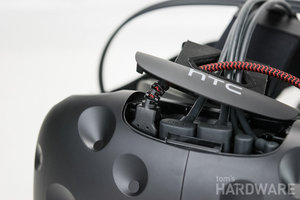

There is an available USB 3.0 port inside the headset, but it's not especially useful. With the Vive Pre, we received a special extension with a right-angle end that fit perfectly inside the slot. Our retail version doesn't include that cable, and the slot is too shallow for a standard USB cable. Without the extension, it won’t be possible to use a USB headset without an additional tether. That'll also make it difficult to use a Leap Motion controller with the Vive.
There’s A Camera
You'll find a camera on the front of the Vive, facing down at a slight angle. This can be used as a pass-through, letting you see what's around you in the real world. There's only a single lens, so there is no depth perception, but at least you get a glimpse of your surroundings with the headset covering your eyes. The camera also activates a portion of the Chaperone safety system.
Phone Integration
HTC is perhaps best known for its mobile phones. The Vive is its first real attempt at an entertainment device. But the company's experience in other segments gives it some advantages here. For instance, the Vive has provisions for interfacing with your phone. The Link Box has a built-in Bluetooth radio that can receive incoming calls while it's on your head. You can get text messages on-screen as well, so you don't have to pull the Vive on and off to check your phone.
This feature was not enabled during our evaluation period, but HTC plans to have the feature working by the time you read this.
Hands In VR
Despite their conceptual similarities, the Vive is a very different beast than Oculus' Rift. For now, the Rift limits you to mostly seated experiences that use a game pad for input. The Vive can technically be used like this as well, but its default control method for most games is one or both of the included tracked controllers. These are wand-like devices that can be used for a surprising number of natural-feeling interactions. They offer six degrees of freedom (6DoF) and feature several buttons that can be implemented in different ways. A trackpad on the face of the controller is in easy reach of your thumb. And you'll find the menu button directly above the track pad, along with a slightly larger system button below it. This lower button is used to access the SteamVR interface while you're in-game; it's also how you turn the controllers on and off
There are two grip buttons, one on each side. Both are mapped to the same control, so you never have to worry about which one to press. Just squeeze. The back side of the controller features a textured finish and a trigger switch that is pressure-sensitive. In our experience, this is the most frequently used input button for Vive games. It is often used as a trigger for a gun, or simply to grab items in the virtual world. The Vive controllers include force feedback motors that rumble to add a subtle haptic effect.
Each controller has an LED light, found on the top side. The light is blue when the controller is on but not being tracked, and it's green when the tracking is working properly. The status light glows orange as the internal batteries charge.
There's a doughnut-shaped structure on the top of each controller, which houses sensors that detect infrared light and is used to determine position/orientation relative to the two base stations.
Early incarnations of the Vive controllers communicated directly with the PC through a receiver, but HTC changed the design for the Vive Pre and final retail version. Now the controllers interface wirelessly with the headset itself, and all of the tracking information is sent to the PC through the HMD's USB connection.
The Vive controllers are much larger than Oculus' Touch prototype, but I won't say they're bulky. From tip to tip, the controllers are a little over eight inches long, and the sensor array is four inches at its widest. The controllers were designed to fit comfortably in your hands, and they are evenly balanced. Each controller weighs 203g. For comparison, a PS4 controller weights 217g and the Xbox One controller that Oculus bundles with the Rift is 263g.
The Base Stations
Tracked controllers are exciting, and they allow for incredible experiences that wouldn’t otherwise be possible, but they aren't unique to the Vive. The Rift will have its Touch controllers out later this year, and even Sony is implementing Move controllers with its upcoming PSVR system. Tracked controllers go hand in hand with VR (pun intended), and every platform will support them eventually.
What really sets the Vive apart from the other HMDs is its ability to facilitate moving around with one-to-one tracking. HTC is selling the depth of immersion, such that you'll be able to walk up to something for a better view or dodge bullets by stepping out of the way. HTC and Valve call this concept of moving around "room-scale VR," and the key to it is occlusion-free tracking with IR sensors.
The base stations for the HTC Vive sit in opposing corners of a room, facing each other at a slight angle towards the ground. One base station emits an array of horizontal infrared light and the opposing one emits a vertical array in the other direction. The sensors on the headset and the two Vive controllers detect these grids of light and send the information to the computer, which is used to triangulate your position in 3D space.
Behind the window on the base station, there's a channel indicator LED and status light that shows if the stations see each other. When the lights are green, they can. If one of the lights is blue, the two stations can't see each other (there is an optional sync cable you can use if that happens).
The base stations feature two tripod/speaker mount threads, one on the rear and the other on the bottom, enabling multiple placement options. The back side is where you’ll find the AC power port, a jack for the optional sync cable, a channel select button and a USB port used for firmware updates.
Other than communicating with each other, the Vive base stations don't transmit or record any data. They are simply plugged into power. The headset does all the heavy lifting.
| Header Cell - Column 0 | HTC Vive Specs |
|---|---|
| Display Type & Size | Dual low-persistence AMOLED (Diamond PenTile subpixel matrix)* |
| Display Size | TBA |
| Resolution | 1200 x 1080 (per eye) |
| Refresh Rate | 90Hz |
| Field of View | 110-degrees |
| Lens Type | Fresnel |
| Lens Adjustment | IPD, lens-to-eye distance (“eye-relief” adjustment) |
| Sensors | Accelerometer, gyroscope |
| Tracking Technology | 6 DOF Laser-based positioning using "Lighthouse" Base Stations |
| Integrated Camera | Yes |
| Audio | Microphone, jack for external headphones |
| Wireless | Bluetooth 4.1 (in Link Box) for Base Stations and cell phone |
| HMD Ports | HDMI 1.4, USB 3.0 x 2 |
| HMD Cable Length | 5 m (plus 1 m from Link Box to PC) |
| Materials Used | Plastic, glass, foam rubber |
| Dimensions | ~190mm x ~127mm x ~89 – 127mm (W x H x L, length excludes headband, min eye-relief to max eye-relief) |
| Weight | 563g (excluding cable) |
| Row 17 - Cell 0 | Vive Controller Specs |
| Input | Analog trigger, touchpad/d-pad, menu button, system button |
| Haptic Feedback | Embedded vibration motors |
| Battery | Internal Lithium Polymer (LiPo) battery pack (mAh unknown) |
| Battery Life | 5+ hours |
| Materials | Plastic |
| Dimensions | Handle: ~180mm x ~52mm x ~32mm, Sensor Array: ~118mm x ~100mm x 42mm, Overall Length: ~220mm |
| Weight | 207g |
Current page: What's In The HTC Vive Box
Prev Page Introduction & Overview Next Page System Requirements & Setup ProceduresKevin Carbotte is a contributing writer for Tom's Hardware who primarily covers VR and AR hardware. He has been writing for us for more than four years.
-
comedichistorian Well it looks like as of 7:30 AM on April 5th you can't order one from the official site if you're from the US or Australia. It doesn't say this anywhere on the site, they just won't let you continue on after the order summary. However, if I select "Ireland" as my location I am able to go to the next step and presumably complete the order. Anyone have any ideas as to what this might mean? Anyone else able to actually complete an order after having selected US?Reply -
DrakeFS They have got to do something about that cable. I fully expect a base station and belt receiver accessories to be sold soon, probably not by HTC\Oculus though. The latency that a wireless solution would add to an application sensitive to latency may be the reason both HMDs are cabled. Then again, it could just be cost, after all $800 sounds a lot better than $1000.Reply
Guess if it annoys me enough, I could always do a ceiling mount. -
comedichistorian Ooooh yeah I like that idea. An easy/cheap yet surprisingly reliable option would be one of those Command Strip units. Get a few loops that'll hold 5lbs and mount them wherever needed in your room and you're done. Those things really hold up, I've mounted heavy pictures with them and they've been holding up fine even with all the temp changes and a small quake we got here.Reply -
turkey3_scratch This makes me now want to dish out the extra $200 for this over the Oculus. Except, I actually don't have the open room, I don't even have 5x5 feet so I don't think it's a possibility.Reply -
kcarbotte ReplyThey have got to do something about that cable. I fully expect a base station and belt receiver accessories to be sold soon, probably not by HTC\Oculus though. The latency that a wireless solution would add to an application sensitive to latency may be the reason both HMDs are cabled. Then again, it could just be cost, after all $800 sounds a lot better than $1000.
Guess if it annoys me enough, I could always do a ceiling mount.Ooooh yeah I like that idea. An easy/cheap yet surprisingly reliable option would be one of those Command Strip units. Get a few loops that'll hold 5lbs and mount them wherever needed in your room and you're done. Those things really hold up, I've mounted heavy pictures with them and they've been holding up fine even with all the temp changes and a small quake we got here.
The problem with a ceiling mount is the length of the cable isn't enoug for that.
you'd have to run the cable up the wall, which would require at least 7 feet, likely more, than across the ceiling to your play space - which would be around 5 feet from the wall or more.
You might have enough range to reach your head, but you definitly won't be walking around in a room-scale space like that.
The cable is somethign we're just going to have to live with for now. It's not going away for the first generation, so get used to it. We're looking at probably two years or more with the current hardware before any major iterations hit the market. I may be wrong about that, it could end up being like the cell phone market, but for now, this is what we have to work with.
It's really not as big of a concern as people think. Yes, you are aware of it always. No, it doesn't detract from the experience enough to brush it off due to a tether. -
Borisblade7 ReplyThey have got to do something about that cable. I fully expect a base station and belt receiver accessories to be sold soon, probably not by HTC\Oculus though. The latency that a wireless solution would add to an application sensitive to latency may be the reason both HMDs are cabled. Then again, it could just be cost, after all $800 sounds a lot better than $1000.
Yeah its teh latency added by the wifi. Until someone finds some work around, its going to be cabled. It doesnt matter so much with the Rift since you can only sit on your ass and play it, but with this being superior with its ability to actually move around, being tethered can cause issues. Having said that, most every vid i've seen of people using this, it really wasnt much of an issue.
-
kcarbotte ReplyThis makes me now want to dish out the extra $200 for this over the Oculus. Except, I actually don't have the open room, I don't even have 5x5 feet so I don't think it's a possibility.
You can filter the SteamVR store to show you what is available for Standing experiences. These games still use the hand controlls, but they don't required that you walk around.
A quick search on steam showed there are 54 titles that support standing configurations and don't need room scale.
Over 30 of those titles launched today and are true VR games designed from the ground up on Vive.
http://store.steampowered.com/search/#sort_by=Released_DESC&sort_order=DESC&category1=998&tags=-1&vrsupport=101%2C302&page=1
-
kcarbotte ReplyThey have got to do something about that cable. I fully expect a base station and belt receiver accessories to be sold soon, probably not by HTC\Oculus though. The latency that a wireless solution would add to an application sensitive to latency may be the reason both HMDs are cabled. Then again, it could just be cost, after all $800 sounds a lot better than $1000.
Yeah its teh latency added by the wifi. Until someone finds some work around, its going to be cabled. It doesnt matter so much with the Rift since you can only sit on your ass and play it, but with this being superior with its ability to actually move around, being tethered can cause issues. Having said that, most every vid i've seen of people using this, it really wasnt much of an issue.
For smooth graphics in VR, the target is 11.11ms of latency. GPUs are just barely able to deliver that reliably over HDMI, adding a wireless signal in there will make it far higher, making it infeasible for the majority of people.
I'm sure there's a wireless version in some research lab somewhere, but we're likely going to have to wait a while for that to hit consumer markets. -
hoofhearted Intel NUC, GTX980 MXM, a lith battery and a backpack will solve the cable issue. Maybe something that converts methane gas to electricity combined with an anal probe will solve the power issue. Throw in a free can of beans.Reply
